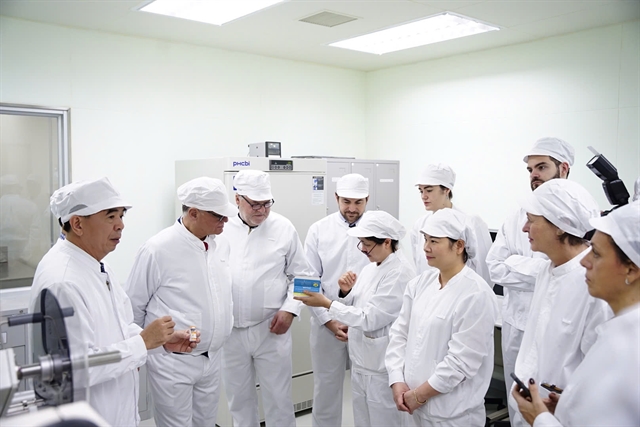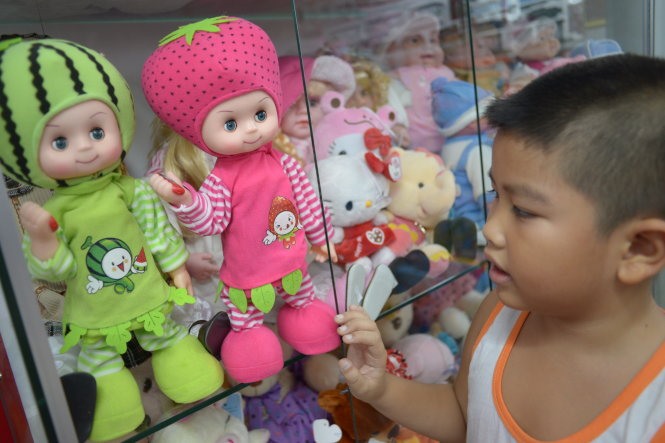

Children living in villages where lead-acid batteries are recycled are known to be at elevated risk of lead poisoning, as are children living near smelters or in cities, experts say
 |
| Unsafe toys are a potent source of lead contamination in children, a state-level research says. — Photo tuoitre.vn |
HÀ NỘI – Children living in villages where lead-acid batteries are recycled are known to be at elevated risk of lead poisoning, as are children living near smelters or in cities, experts say.
Doãn Ngọc Hải, Director of the National Institute of Occupational and Environmental Health (NIOEH), told Tuổi Trẻ (Youth) newspaper that the institute is conducting state-level research on lead poisoning of Vietnamese children and the effectiveness of intervention measures.
The research is being conducted in the northern provinces of Thái Nguyên, Hưng Yên, Bắc Kạn – where there are lead-related metallurgy operations.
A survey in Tân Long Commune, located near the Làng Hích lead mine in Thái Nguyên province, found an alarming rate of lead poisoning, in both children and adults.
Children’s normal blood lead should be less than 5mcg/dl. However, blood lead level (BLL) tests performed on 209 children aged three to 14 in the commune showed that half – 109 children – had over 10mcg per decilitre.
In 105 children, it reached 10-44mcg/dl, meaning mild lead poisoning, while four children suffered medium-degree poisoning with BLL greater than 45mcg/dl.
Another study, conducted in Phú Xá ward of Thái Nguyên City, where smelting and steelmaking operations take place, showed that 78 out of 180 children in that same age group recorded BLL higher than 10mcg/dl. Among them, 66 were found suffering from "mild intoxication" and 12 from medium-degree poisoning.
Analysis of three out of 30 water samples, 12 soil samples, and two of 10 food samples in the area showed higher lead measurements than the permitted levels.
Lỗ Văn Tùng, secretary of the research, said lead contamination might come from the very air, soil or water to which children are exposed. Unsafe toys could also be a potent source of contamination, he cautioned.
The research team has conducted another study of wall paint and toys used in two kindergartens ịn the area; while wall paint passed the test, some toys were shown to have low-level lead contamination. “The more brightly coloured the toys are, the higher the risks of lead contamination they pose,” Tùng warned.
The research team urged parents to choose toys of known brands and clear origins, with safety labels, preferably lead-free indication tags.
An uphill battle
Within the framework of this research, the team also administered intervention measures to children in the notorious battery-recycling village Đông Mai in Hưng Yên Province from June to September 2016, with positive initial results. One month later, in the follow-up observation conducted in conjunction with the provincial Department of Health and provincial Preventive Medicine Centre, the research team found only a slight reduction in BLL: 65.2 per cent of treated children showed diminished BLL, while 100 per cent of the adults had reduced BLL, down from an average of 43.79mcg/dl to 31.83 mcg/dl.
Still, the research team is not satisfied with the results, and urges more comprehensive environmental restoration measures to seriously reduce lead exposure.
The institute recommended a revamping of working conditions at used lead-acid battery recycling facilities in certain so-called "craft villages", especially informal smelters run by low-income individuals and households which usually flout safety precautions and environmental regulations.
Workers must be equipped with proper hats, gloves, masks and protective clothing and footwear, and are advised to take a shower after work. Workers usually bring contaminated clothes back home and inadvertently expose family members to lead in the process, the research team also noted.
More worrisome is the fact that not only children in these villages or in areas near lead mines are at risk, so are children in cities, with the most prevalent source of lead exosure being a questionable drug that goes by the name ‘thuốc cam’. Literally translated as "orange medicine", it is a traditional powder with detoxification properties that supposedly can cure mouth sores, furry tongue, constipation, as well as galvanise children’s growth. However, the ones sold on the market are usually lacking clear indication of origin and proper labels and ingredient information, and may contain dangerous levels of lead, even mercury and arsenic, said Assoc Dr Vũ Đức Lợi, Vice Director of the Institute of Chemistry under the Việt Nam Academy of Science and Technology.
Poisoning symptoms
According to the Poison Control Centre of Ha Noi’s Bạch Mai Hospital, symptoms of lead poisoning in children are not always visible and can only be determined with certainty by careful examination.
However, poisoned children would show either some or an aggregate of ailments such as anaemia, frequent nausea and vomiting, abdominal pain, loss of appetite and fatigue. In more severe case, the child would be easily irritated, unwilling to co-operate with other family members and classmates, and show signs of hampered intellectual development.
The IQ level is found to be inversely proportional to the blood lead level. Researchers have also discovered a causal relation between levels of lead exposure and the severity of attention deficit hyperactivity disorder (ADHD), especially hyperactivity.
In adults, typical lead poisoning symptoms are inattention, drowsiness, confusion, sleepiness, seizures, headaches, paralysis, metallic taste, loss of appetite, anemia (even in cases of blood lead levels below 10 mcg/dl), impaired fertility and elevated risks of miscarriage.
Intervention treatment and monitoring of lead poisoning might last months, even years, since the body might mistake lead for calcium or iron and a large quantity of lead might be stored in bones and released back to the body during certain physiological changes. – VNS



